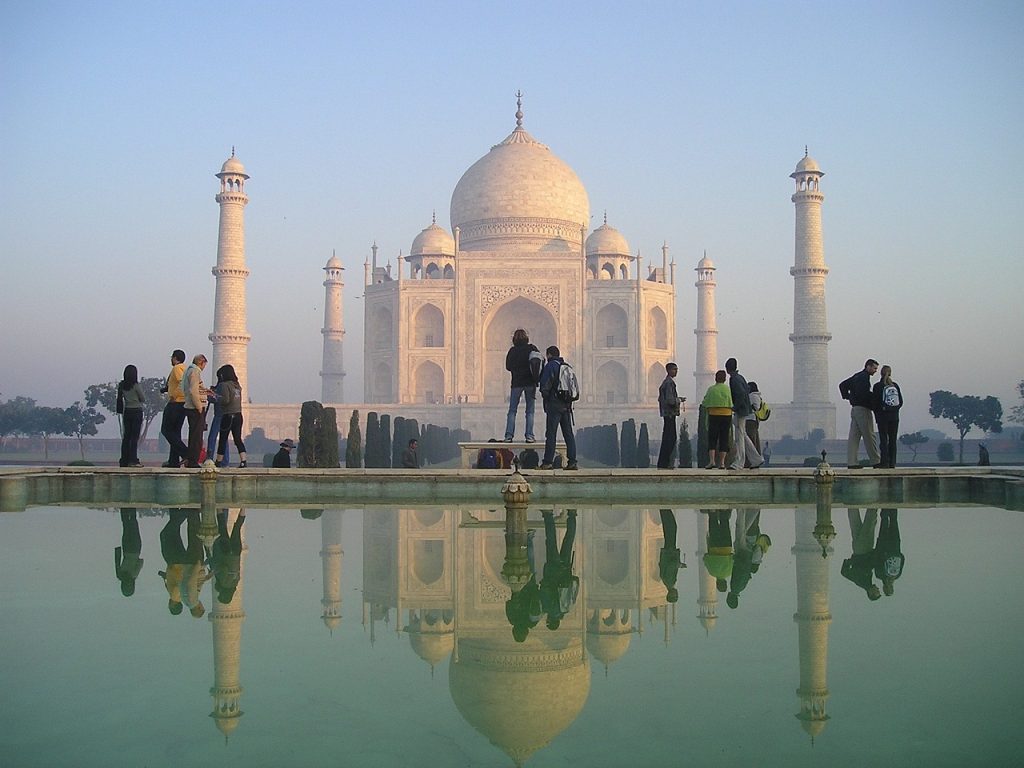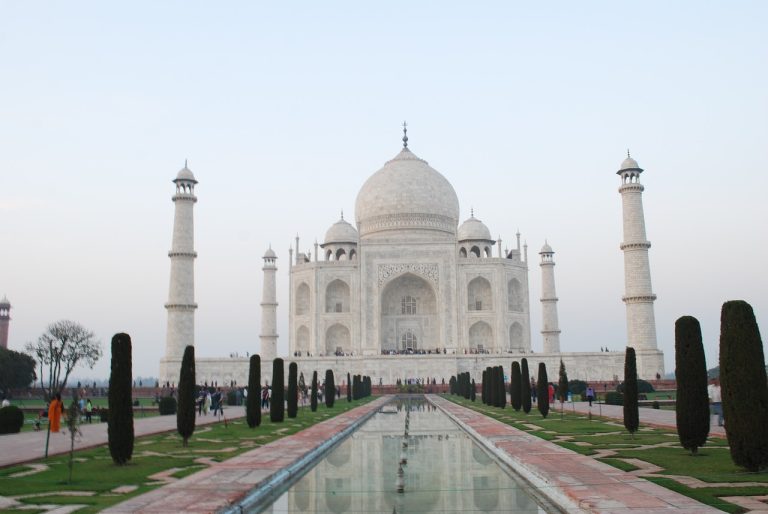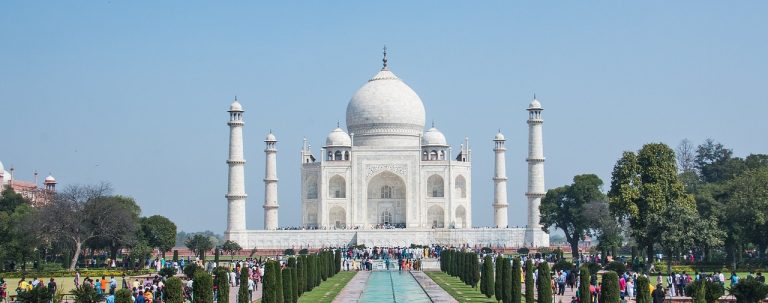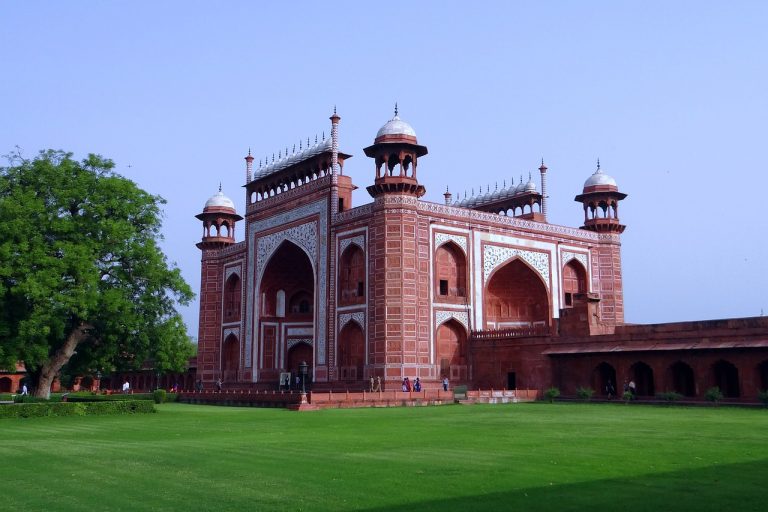Agra India Video
Taj Mahal
The Taj Mahal is one of the most iconic historical landmarks in Agra, India. Built between 1631 and 1648 by Mughal Emperor Shah Jahan in memory of his wife Mumtaz Mahal, it is considered a masterpiece of Mughal architecture.
- Architectural Marvel: The Taj Mahal is renowned for its symmetrical design and exquisite white marble construction. It features intricate carvings, calligraphy, and delicate inlays of precious stones.
- Symbol of Love: The Taj Mahal is a symbol of eternal love and devotion. It is believed to represent the deep affection Emperor Shah Jahan had for his wife. The monument’s beauty and grandeur have made it a UNESCO World Heritage Site.
- Tourist Attraction: The Taj Mahal attracts millions of tourists from around the world each year. It is best experienced during sunrise or sunset when the changing light adds to its enchanting ambiance.
The Taj Mahal showcases a fusion of Persian, Islamic, and Indian architectural styles. Its main dome, minarets, and decorative elements highlight the mastery of Mughal craftsmanship.
Visitors can explore the Taj Mahal’s stunning gardens, reflecting pools, and the mausoleum where Shah Jahan and Mumtaz Mahal are buried.
Visitors can admire the Taj Mahal’s intricate details up close and learn about its fascinating history through guided tours and informative displays.
Agra Fort
Agra Fort, also known as the Red Fort of Agra, is another prominent historical landmark in Agra. It served as the main residence of the Mughal emperors until the capital was shifted to Delhi.
- Architectural Grandeur: Agra Fort showcases a blend of Islamic, Hindu, and Persian architectural styles. Its red sandstone walls, impressive gates, and intricate palaces reflect the opulence of the Mughal era.
- Historical Significance: Agra Fort witnessed several significant events in Indian history. It was the site where Emperor Shah Jahan was imprisoned by his son Aurangzeb and from where he gazed at the Taj Mahal until his death.
- Spectacular Views: Agra Fort offers breathtaking views of the Taj Mahal from its ramparts. Visitors can capture stunning photographs of the iconic mausoleum framed by the fort’s arches and domes.
The fort’s notable structures include the Diwan-i-Am (Hall of Public Audience), Diwan-i-Khas (Hall of Private Audience), and Jahangiri Mahal (Jahangir’s Palace).
Exploring the fort allows visitors to immerse themselves in the stories of Mughal emperors, their lavish lifestyles, and the political intrigues of the time.
The fort’s strategic location on the banks of the Yamuna River provides a picturesque backdrop for the Taj Mahal.
Agra India Image 1:

Fatehpur Sikri
Fatehpur Sikri is a historical city located near Agra. Constructed by Emperor Akbar in the late 16th century, it served as the capital of the Mughal Empire for a brief period.
- Architectural Splendor: Fatehpur Sikri showcases a unique blend of Mughal, Persian, and Hindu architectural styles. Its buildings are made of red sandstone and feature intricate carvings, ornamental arches, and spacious courtyards.
- Religious Significance: The city houses several religious sites, including the revered Sufi saint Salim Chishti’s tomb. Pilgrims visit the tomb seeking blessings and tying threads on the marble screens as a symbol of their prayers.
- Abandoned City: Fatehpur Sikri was abandoned due to water scarcity issues. However, its well-preserved structures and historical importance have made it a UNESCO World Heritage Site.
The Jama Masjid, Buland Darwaza, and Panch Mahal are among the notable structures within Fatehpur Sikri.
The spiritual ambiance of Fatehpur Sikri attracts people from various faiths, making it a significant pilgrimage site.
Exploring the deserted city allows visitors to imagine its former glory and understand the architectural brilliance of the Mughal era.
Agra India Image 2:
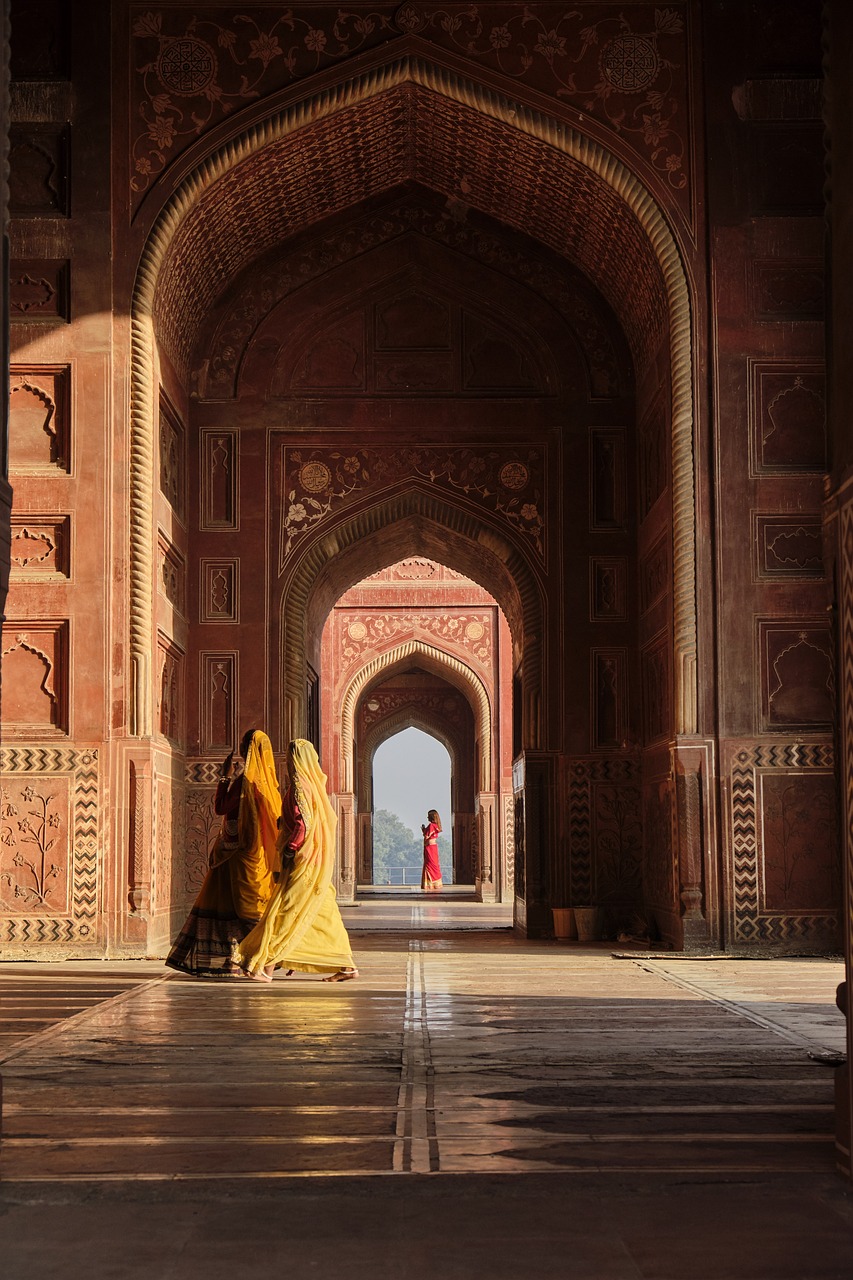
Itmad-ud-Daulah’s Tomb
Itmad-ud-Daulah’s Tomb, often referred to as the “Baby Taj,” is a beautiful mausoleum located on the banks of the Yamuna River in Agra. It was commissioned by Nur Jahan, the wife of Emperor Jahangir, in memory of her father.
- Exquisite Architecture: The tomb showcases intricate marble work, delicate inlays, and elaborate motifs. It is considered a precursor to the Taj Mahal and features a similar design aesthetic.
- Historical Significance: Itmad-ud-Daulah’s Tomb is the first Mughal structure in India to be entirely made of marble. It holds immense historical importance as it marks the transition from red sandstone to white marble in Mughal architecture.
- Riverside Location: The tomb’s location on the banks of the Yamuna River provides a serene and picturesque setting. Visitors can enjoy scenic views while exploring the intricacies of the mausoleum.
The use of white marble, geometric patterns, and floral embellishments adds to the tomb’s elegance.
Visitors can learn about the influence of Persian and Islamic architectural styles on the tomb’s design.
The surrounding gardens and pathways offer a tranquil environment for relaxation and contemplation.
Agra India Image 3:
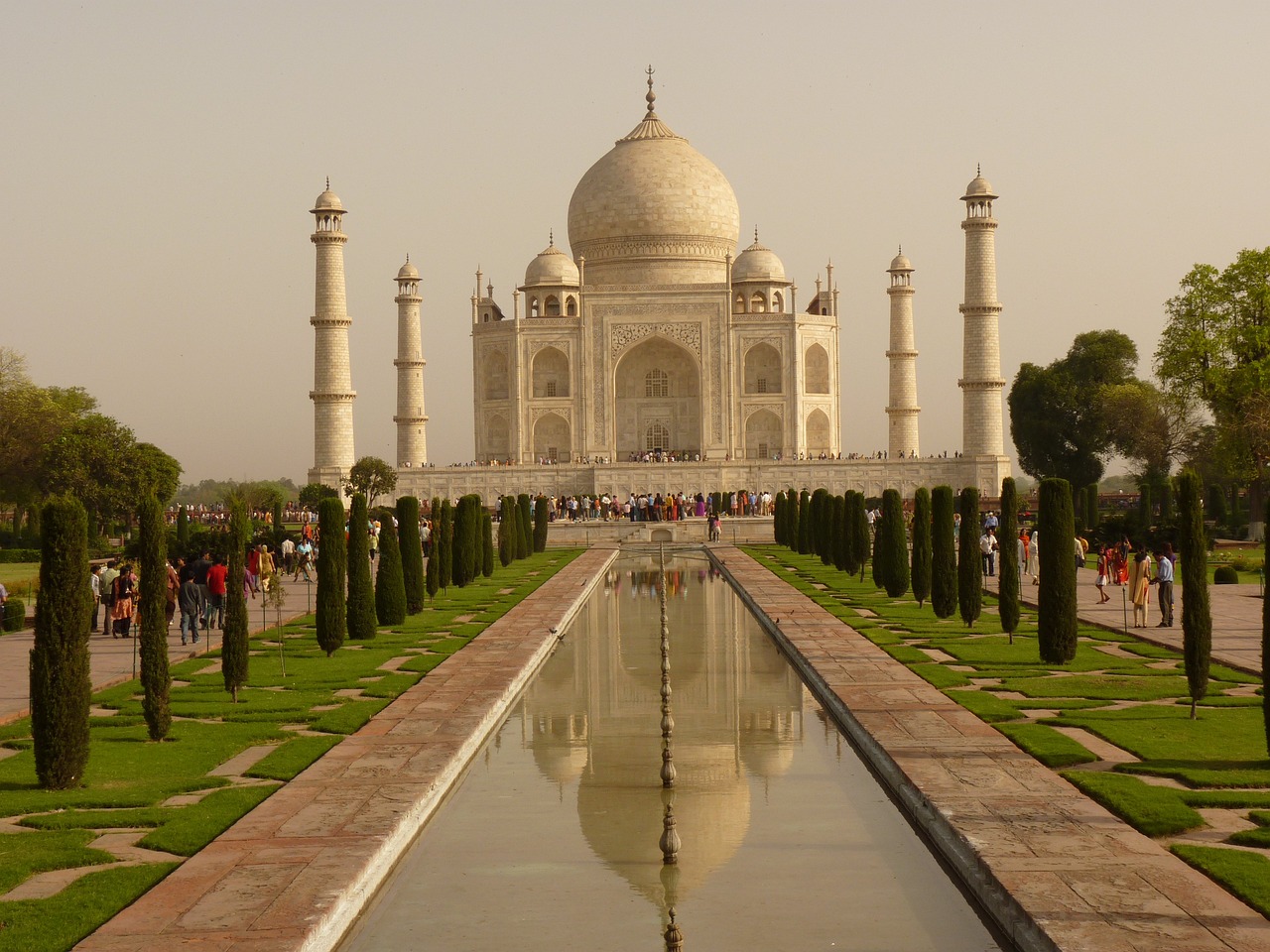
Moti Masjid
Moti Masjid, also known as the Pearl Mosque, is a stunning mosque located within the premises of Agra Fort. It was built by Emperor Shah Jahan in the mid-17th century.
- Architectural Beauty: Moti Masjid is constructed entirely of white marble, giving it a radiant appearance. Its three domes, minarets, and intricate carvings showcase the exquisite craftsmanship of the Mughal era.
- Religious Significance: Moti Masjid served as a place of worship for the Mughal emperors and their courtiers. It continues to be an active mosque where prayers are offered regularly.
- Historical Context: Moti Masjid reflects the religious tolerance prevalent during the Mughal period. It stands as a testament to the empire’s architectural achievements and its embrace of diverse cultures and faiths.
The mosque’s tranquil courtyard and prayer hall provide a serene atmosphere for worship.
Visitors can witness the devotion of worshippers and experience the spiritual ambiance of the mosque.
Exploring Moti Masjid offers insights into the Mughal Empire’s rich history and its architectural legacy.
Mughal Heritage Walk
The Mughal Heritage Walk is a guided tour that allows visitors to explore the lesser-known historical gems of Agra. It provides a unique perspective on the city’s rich Mughal heritage.
- Off the Beaten Path: The Mughal Heritage Walk takes visitors through narrow lanes, hidden alleys, and local markets, providing an authentic experience of Agra’s vibrant culture.
- Hidden Treasures: The walk showcases lesser-known monuments, tombs, and havelis (traditional mansions) that are not typically part of the regular tourist itinerary.
- Local Stories: The tour guides share fascinating stories and anecdotes about the Mughal era, providing insights into the lives of emperors, queens, and commoners.
Participants can interact with locals, taste traditional delicacies, and discover hidden architectural gems.
Exploring these hidden treasures offers a deeper understanding of Agra’s historical significance and architectural diversity.
Participants can immerse themselves in the rich history and cultural heritage of Agra through these captivating narratives.
Akbar’s Tomb
Akbar’s Tomb, also known as Sikandra, is the final resting place of Emperor Akbar. Located on the outskirts of Agra, it is a magnificent mausoleum that reflects the emperor’s secular beliefs and architectural vision.
- Architectural Marvel: Akbar’s Tomb features a blend of Islamic, Hindu, and Jain architectural elements. The red sandstone structure is adorned with intricate carvings, geometric patterns, and calligraphy.
- Secular Ideals: Akbar was known for his religious tolerance and promotion of syncretism. His tomb reflects his inclusive beliefs by incorporating elements from various religions, including Hindu motifs and Jain architectural features.
- Serene Surroundings: Akbar’s Tomb is set amidst lush gardens, providing a tranquil environment for contemplation and relaxation. The expansive greenery enhances the beauty of the mausoleum.
The tomb’s grand entrance, spacious courtyard, and four-tiered minarets highlight the architectural prowess of the Mughal era.
Visitors can appreciate the emperor’s vision of unity and harmony through the architectural symbolism present in the tomb.
Exploring the tomb’s surroundings allows visitors to connect with nature and appreciate the peaceful ambiance.
Mehtab Bagh
Mehtab Bagh, also known as the Moonlight Garden, is a beautiful garden complex located on the opposite bank of the Yamuna River from the Taj Mahal. It offers breathtaking views of the iconic mausoleum.
- Scenic Beauty: Mehtab Bagh provides an ideal vantage point to admire the Taj Mahal. The garden’s well-maintained pathways, lush greenery, and fountains create a picturesque setting.
- Historical Significance: Mehtab Bagh was originally designed as part of the Taj Mahal complex. It served as a charbagh (four-part garden) and provided a symmetrical view of the mausoleum.
- Relaxation and Recreation: Mehtab Bagh offers a serene atmosphere for leisurely walks, picnics, and photography. Visitors can unwind amidst the natural beauty and capture stunning photographs of the Taj Mahal from different angles.
Visitors can enjoy panoramic views of the Taj Mahal without the crowds, especially during sunrise and sunset.
The garden’s historical connection with the Taj Mahal adds to its allure and significance.
The garden’s tranquil ambiance makes it an ideal spot for relaxation and contemplation.
Sadar Bazaar
Sadar Bazaar is a bustling market in Agra known for its vibrant atmosphere and diverse shopping options. It offers a glimpse into the local lifestyle and is a popular destination for tourists.
- Shopping Extravaganza: Sadar Bazaar is a shopaholic’s paradise. It offers a wide range of products, including handicrafts, textiles, jewelry, leather goods, and marble souvenirs.
- Local Flavors: The market is dotted with food stalls and restaurants serving delicious street food and traditional Agra delicacies. From spicy chaats to mouthwatering sweets, Sadar Bazaar offers a culinary adventure.
- Cultural Immersion: Sadar Bazaar provides an opportunity to interact with locals and experience the vibrant culture of Agra. The market’s lively atmosphere, colorful shops, and bustling crowds create a memorable experience.
Visitors can indulge in retail therapy and find unique items to take back as mementos.
Exploring the local food scene allows visitors to savor the authentic flavors of Agra.
Immersing oneself in the local culture adds a unique dimension to the visit.
Conclusion
Agra, India, is a treasure trove of historical landmarks that showcase the rich legacy of the Mughal Empire. From the iconic Taj Mahal to the majestic Agra Fort, each monument reflects the architectural brilliance and cultural heritage of the bygone era.
Exploring Agra’s historical landmarks offers a glimpse into India’s glorious past and allows visitors to

